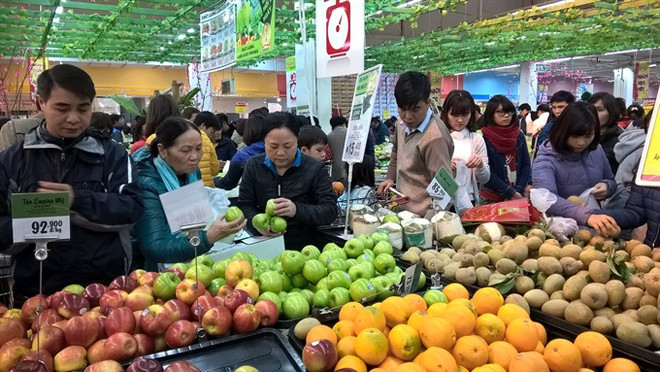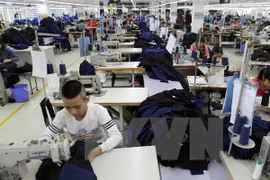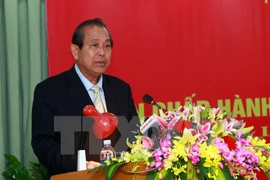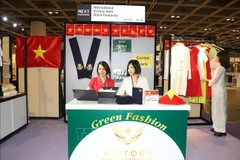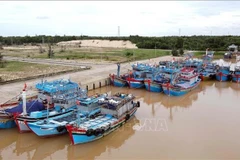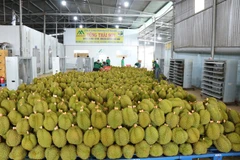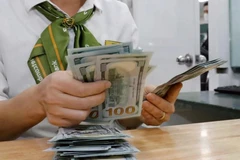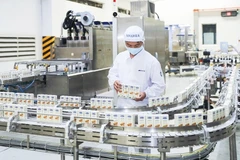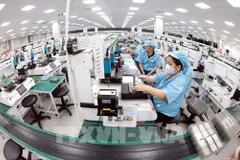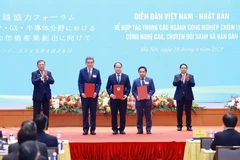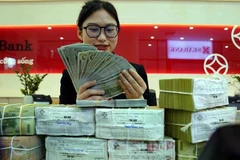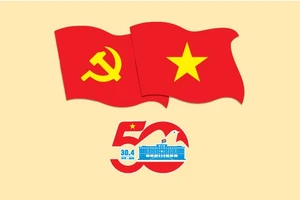TheVEPR’s macroeconomic report on the fourth quarter of 2016 and on the year insummary said Vietnam’s economy showed signs of gradual recovery thanks to themanufacturing sector and stability in the agriculture sector, bringing thetotal annual growth rate to 6.21 percent. The fourth quarter GDP recordedgrowth of 6.68 percent, higher than that of the third quarter at 6.56 percent.
TheVietnam Economic Performance Index (VEPI) also rose significantly in the fourthquarter, reaching 6.53 percent, 0.5 higher than in the third quarter, anotherindication of the economy’s strength.
Withthe purchasing managers index (PMI) maintained at over 50 points throughout2016, an increase of 16.2 percent in the number of newly established businessesand a 48.1 percent increase in registered capital compared to 2015, thebusiness sector had been a driving force for the economy.
FormerMinister of Industry and Trade Truong Dinh Tuyen also agreed that the businesssector, chiefly manufacturing and processing, had grown steadily. But he notedthat employment and new jobs had decreased slightly from 2015, indicating aless labour-oriented economic structure.
Theagricultural sector, accounting for 11 to 13 percent of total gross domesticproduct (GDP), only grew 0.72 percent during 2016 and only contributed 0.09 percentto total GDP growth, with aquaculture growing at 1.36 percent, the lowest inthe past six years.
PhamChi Lan, an independent economic researcher, said that the Government shouldfocus more on agricultural development, as well as environmental protection andsustainable development.
Exportturnover had a significant growth of 13.5 percent, while import turnover had agrowth of 16.1 percent in the last three months of 2016, mainly due to pricerecovery.
Theforeign exchange market stabilised after a year of applying the centre ratemechanism, though the exchange rates fluctuated wildly in the fourth quarter of2016. Foreign exchange reserves continued to increase steadily in 2016,clocking in at a record 41 billion USD at the end of the year.
Monetarypolicy for 2016 was flexible and precise, with the State Bank of Vietnam (SBV)staying close to the set inflation goal. Increases in capital flow, credit flowand capital mobilisation reached the planned figures set the by the SBV, whileinterest rates were kept stable thanks to the balance between capital andcredit mobilisation. However, government control of inflation should be evenmore flexible in the coming year.
Declinein FDI
Inaddition to these mostly positive signs, other sectors of the economy declined,such as foreign direct investment disbursement with a slight downturn in thefourth quarter, despite a peak of 15.8 billion USD in anticipation of theTrans-Pacific Partnership (TPP). FDI will possibly continue to shrink in lightof plans by President-elect Donald Trump to abandon the TPP in 2017.
Furthermore,the Government budget deficit at 5.64 percent of total GDP was still over theset goal, though less than the previous year. The deficit was still at a severelevel, with spending increasing regularly and shifts in revenue.
Domesticgold price showed a discrepancy with world gold prices in the fourth quarter,as the latter dropped after the Federal Reserve decided to increase interestrates while the former rose due to anxiety over the dollar exchange rates.
Thereal estate market continued to grow compared to the middle of the year, withboth price index, supply and number of transactions going up, though hope forthis market is slim due to foreseeable anxiety over future interest rates.
Regardingthe year 2017’s expectation, VEPR asserted that the growth target of 6.7 percentset by the Government is somewhat improbable, with signs of inflation comingback making the inflation target of 4 percent hard to achieve, as well.
Nonetheless,experts at the institute have high hopes for the business sector as theGovernment is determined to reduce legal procedures for entrepreneurs andimprove the investment climate.
Lastly,budget control will continue to be a challenge with infrastructure requiringsignificant spending, and public debt will accumulate even further. VEPRadvised the Government to crack down on unnecessary spending to maintain abudget balance in 2017, and to be alert to changing world economicdevelopments.
VEPRhas provided quarterly economic reports since the beginning of 2016, supportedby the Ministry of Foreign Affairs and Australia’s Department of ForeignAffairs and Trade as part of a project of independent macroeconomicreports.-VNA
